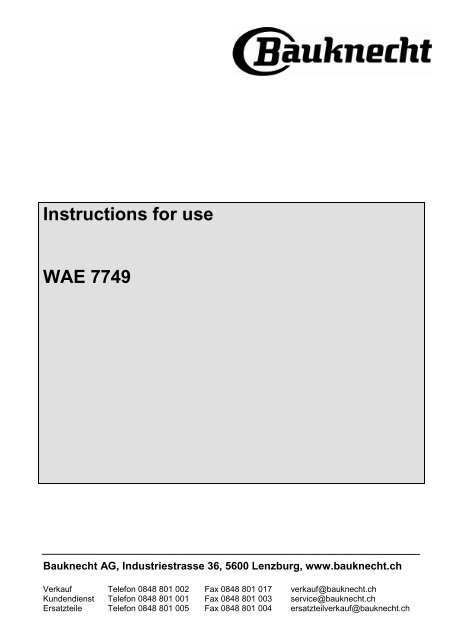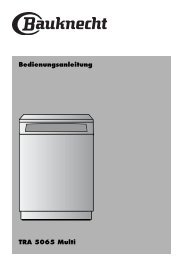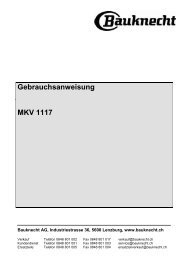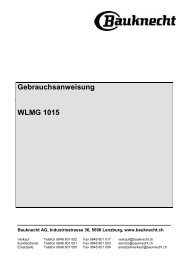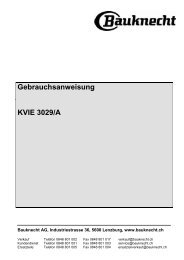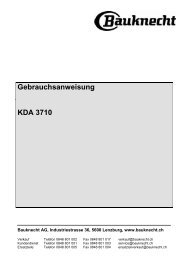Instructions for use WAE 7749 - Bauknecht
Instructions for use WAE 7749 - Bauknecht
Instructions for use WAE 7749 - Bauknecht
Create successful ePaper yourself
Turn your PDF publications into a flip-book with our unique Google optimized e-Paper software.
<strong>Instructions</strong> <strong>for</strong> <strong>use</strong><br />
<strong>WAE</strong> <strong>7749</strong><br />
<strong>Bauknecht</strong> AG, Industriestrasse 36, 5600 Lenzburg, www.bauknecht.ch<br />
Verkauf Telefon 0848 801 002 Fax 0848 801 017 verkauf@bauknecht.ch<br />
Kundendienst Telefon 0848 801 001 Fax 0848 801 003 service@bauknecht.ch<br />
Ersatzteile Telefon 0848 801 005 Fax 0848 801 004 ersatzteilverkauf@bauknecht.ch
GB PROGRAMME CHART<br />
E. Programme selector<br />
F. “Start (Pa<strong>use</strong>)” button<br />
G. “Variable spin” button<br />
H. Programme sequence indicator<br />
I. “Reset/Drain” button<br />
J. “Start delay” button<br />
K. “Temperature” button<br />
L. “Child lock” button combination<br />
M. “Detergent overdosage” indication<br />
A. “Door open” indication<br />
A<br />
B<br />
I<br />
}H<br />
C D<br />
M<br />
J<br />
This washing machine is equipped with<br />
automatic safety functions which detect and<br />
diagnose faults at an early stage and react<br />
appropriately, e.g.:<br />
E F<br />
G<br />
} L<br />
K<br />
B. “Service” indication<br />
C. “Water tap closed” indication<br />
D. “Clean pump” indication<br />
Detergents and additives Special options Max<br />
Pre-<br />
Spin<br />
wash Speed<br />
rpm<br />
Main Softener Clean + Start Pre- Intensive Easy Rinse Variable<br />
wash delay wash rinse ironing hold spin<br />
Clean + Start- Vorwäsche Intensiv Leicht Spülstopp Schleudern<br />
vorwahl<br />
spülen bügeln<br />
Clean + Départ Prélavage Rinçage Repassage Arrêt Essorage<br />
différé<br />
facile Cuve Pleine<br />
Type of wash/Notes<br />
Max.<br />
Load<br />
Care<br />
Labels<br />
Temperature<br />
Programme<br />
- Respect the manufacturer’s recommendations on the<br />
care label<br />
kg<br />
70 - 95 °C 7.0 Normally to heavily soiled bed linen, table linen and underwear, towels, shirts<br />
etc. made of cotton and linen.<br />
White Cotton /<br />
Hygienic +<br />
❉ Yes ❉ ❉ ❉ ❉ ❉ ❉ ❉ ❉ max.<br />
At a temperature of 80°C or more, this programme eliminates bacteria, ensuring<br />
sanitization of your laundry. The bacteria removal efficiency has been tested<br />
following a similar methodology to the NF EN 13697 standard of Nov. 2001.<br />
7.0<br />
20 - 60 °C<br />
Buntwäsche<br />
Couleurs<br />
Coloured<br />
Cotton<br />
Normally soiled blo<strong>use</strong>s, shirts, overalls etc. made of polyester (Diolen, Trevira),<br />
polyamide (Perlon, Nylon) or blends with cotton. ❉ Yes ❉ ❉ ❉ ❉ ❉ ❉ ❉ ❉ max.<br />
3.5<br />
20 - 60 °C<br />
Pflegeleicht<br />
Synthétiques<br />
Synthetics<br />
20 - 40 °C 2.5 Curtains and delicate clothing, dresses skirts, shirts and blo<strong>use</strong>s. ❉ Yes ❉ — ❉ ❉ — — ❉ ❉ 1000 1)<br />
Feinwäsche<br />
Délicat<br />
Delicates<br />
— Yes ❉ — ❉ — — — ❉ ❉ 1000 1)<br />
Only woollens, labelled with the Woolmark and identified as machine washable.<br />
This programme (40°C) is tested and approved by The Woolmark Company <strong>for</strong><br />
Wool 20 - 40 °C 2.0<br />
machine washable wool.<br />
— Yes ❉ — ❉ — — — ❉ ❉ 400 1)<br />
Textiles made of silk, linen, wool and viscose marked as “handwashable”.<br />
This programme (40°C) is tested and approved by The Woolmark Company <strong>for</strong><br />
handwashable wool.<br />
Handwash 20 - 40 °C 2.0<br />
This programme is particularly suitable to treat delicate lingerie (<strong>use</strong> of a laundry<br />
net strongly recommended). — Yes ❉ — ❉ — — — ❉ ❉ 400 1)<br />
20 - 30 °C 2.0<br />
Dessous<br />
Lingerie<br />
Baumwolle Eco<br />
Coton Eco<br />
Lingerie<br />
— Yes ❉ — ❉ — ❉ — ❉ ❉ max.<br />
Heavily soiled and robust laundry washable at 60°C such as bed linen, table linen,<br />
towels etc.<br />
The extended programme duration enables economic energy and water consumption<br />
60 °C 7.0<br />
Eco Cotton<br />
❉ Yes — — ❉ — ❉ ❉ ❉ ❉ max.<br />
while maintaining good washing results.<br />
Normally soiled and sweaty sportswear made of cotton jersey or microfibers.<br />
This programme includes a prewash cycle – you can add detergent also to the<br />
prewash chamber. Do not add any softener.<br />
Normally to heavily soiled and robust bed linen, table linen and underwear,<br />
towels, shirts etc. made of cotton and linen.<br />
Offers highest economy in energy consumption by prolonged washing duration. Ideal<br />
to be run overnight to additionally profit from the more favourable energy rates. To<br />
avoid noise of spinning at night, set spin speed to “0” and start spin programme in the<br />
morning, or define programme start with “Start delay” accordingly.<br />
3.5<br />
Sport Sport 20 - 30 °C<br />
— Yes ❉ — ❉ — ❉ — ❉ ❉ max.<br />
Super Eco Super Eco 20 - 60 °C 7.0<br />
6.0 Slightly to normally soiled textiles made of cotton and/or synthetics. — Yes ❉ — ❉ — ❉ ❉ ❉ ❉ max.<br />
20 - 60 °C<br />
Mischwäsche<br />
Mixte<br />
Daily load<br />
— Yes ❉ — ❉ — — — ❉ ❉ max.<br />
Refreshes briefly worn outer clothing made of cotton, artificial fibers and blends<br />
with cotton.<br />
20 - 30 °C 3.0<br />
Kurz 15<br />
Chrono 15<br />
Spülen & Schleudern<br />
Rinçage & Essorage<br />
Schleudern<br />
Essorage<br />
Speed 15<br />
Use lowest recommended detergent amount.<br />
— — 7.0 Same as the last rinse and the final spin in the “Cotton” programme. — — ❉ — ❉ — ❉ — ❉ ❉ max.<br />
Rinse & Spin<br />
In this programme spinning is intensive. Same as the spin cycle in the “Cotton”<br />
programme. — — — — ❉ — — — — ❉ max.<br />
— — 7.0<br />
Spin<br />
The wool and handwash cycles of this machine have been tested and approved by The Woolmark Company <strong>for</strong> the washing of<br />
Woolmark garments labelled as “machine wash” or “hand wash” provided that the garments are washed according to the<br />
instructions on the garment label and those issued in this programme chart. M0702 5019 401 05516<br />
❉: optional / Yes : dosing required<br />
1) For improved garment care, spin speed is restricted in this programme.
The sensor Technology automatically adapts Programme Time, Water and Energy consumption to the size of your wash load.<br />
“DOOR OPEN” INDICATION<br />
START DELAY<br />
CONSUMPTION DATA<br />
Be<strong>for</strong>e starting and after end of a programme, the lamp lights to show<br />
that the door can be opened. As long as a wash programme is running,<br />
the door remains locked and must on no account be <strong>for</strong>ced open. In<br />
case you have an urgent need to open it during a running programme,<br />
refer to “Reset a running programme be<strong>for</strong>e the end”.<br />
RED INDICATIONS<br />
“Service”<br />
Lighting up of the “Service” indication can be ca<strong>use</strong>d by a fault in an<br />
electrical component. Refer to the “Troubleshooting Guide” in your<br />
<strong>Instructions</strong> <strong>for</strong> Use; if the fault persists, contact our After Sales Service.<br />
“Water tap closed”<br />
The appliance has no or insufficient water supply. Open the water<br />
tap; if the indication still lights up, refer to the “Troubleshooting<br />
Guide” in the <strong>Instructions</strong> <strong>for</strong> Use.<br />
“Clean pump”<br />
Waste water is not pumped out. Check whether the drain hose is<br />
kinked or the filter must be cleaned; in the latter case refer to the<br />
<strong>Instructions</strong> <strong>for</strong> Use (“Removing the Filter”).<br />
PROGRAMME END<br />
The display shows “End” and the “Door open” indication lights.<br />
1. Turn the programme selector to the “Off/O” position.<br />
2. Close the water tap.<br />
3. Open the door and unload the machine.<br />
Leave the door ajar to allow the drum to dry.<br />
The “Start delay” allows to run the machine at the consumer’s<br />
convenience, <strong>for</strong> example at night when electricity is cheaper. Do<br />
not <strong>use</strong> liquid detergent when activating the “Start delay”.<br />
Select programme, temperature and options.<br />
Press the “Start delay” button to select a delay time up to 23<br />
hours; the light of the “Start (Pa<strong>use</strong>)” button blinks.<br />
Press the “Start (Pa<strong>use</strong>)” button; the countdown of the delay<br />
time begins. The light of the “Start (Pa<strong>use</strong>)” button stops<br />
blinking and is on; the light of the start delay button will keep<br />
blinking until the programme starts.<br />
As soon as the programme starts, the start delay on the display<br />
is replaced by the remaining programme time, and the light of<br />
the “Start delay” button goes off.<br />
Once having pressed the “Start (Pa<strong>use</strong>)” button, the number<br />
of hours preselected can be changed by pressing and holding<br />
the “Start delay” button.<br />
To cancel the “Start delay”<br />
..be<strong>for</strong>e you press “Start (Pa<strong>use</strong>)”:<br />
Turn the programme selector to another position or press the<br />
“Reset/Drain” button.<br />
..after having pressed “Start (Pa<strong>use</strong>)”:<br />
Press “Start (Pa<strong>use</strong>)” - the delay time disappears from the<br />
display; press “Start (Pa<strong>use</strong>)” again to start the selected<br />
programme immediately.<br />
PROGRAMME START<br />
DETERGENT OVERDOSAGE INDICATION<br />
In case you <strong>use</strong>d too much detergent, a small vertical bar will light<br />
next to the overdosage symbol on the right of the display when<br />
the wash programme is finished; <strong>use</strong> less detergent next time. Too<br />
much foam by detergent overdosing can also lead to interruption<br />
of a wash cycle; in this case the display shows “Fod” - follow the<br />
recommendations in the “Troubleshooting Guide” in your<br />
Open the tap and press “Start (Pa<strong>use</strong>)”; the light stops blinking and is on.<br />
The programme sequence indicator shows the current programme<br />
phase, running from left to right through Wash, Rinse, Spin/Drain.<br />
The display shows the remaining programme time. Due to<br />
variations in load and temperature of inlet water, the remaining<br />
time is newly calculated in certain programme phases. If this is the<br />
case, an animation appears on the display.<br />
Activating the child lock prevents children from starting a wash<br />
cycle or changing the settings of a running programme. The child<br />
lock cannot be activated or deactivated when the programme<br />
selector is in the “Off/O” position. To activate the child lock:<br />
Turn the programme selector to a programme position, or run<br />
a programme as usual.<br />
Press the 2 buttons marked with the key symbol<br />
simultaneously <strong>for</strong> at least 3 seconds; a key-like symbol will shortly<br />
appear on the display to indicate that the child lock is active.<br />
Any time you try to change a programme setting with active child<br />
lock, the display will shortly show the key-like symbol. The<br />
programme setting cannot be changed anymore; the only change<br />
possible is to switch the washer off by turning the programme<br />
selector to the “Off/O” position. To deactivate the child lock:<br />
Press again the 2 buttons marked with the key symbol<br />
simultaneously <strong>for</strong> at least 3 seconds.<br />
Temperature Load Water Energy Approx. Programme Duration<br />
Programme<br />
(°C) (kg) (l) (kWh)<br />
(hours : minutes)*<br />
White Cotton / Hygienic + 95 7.0 74** 2.10 2:10<br />
Coloured Cotton 60 7.0 54 1.19 2:20<br />
Coloured Cotton 40 7.0 69 0.75 2:05<br />
Synthetics 60 3.5 46** 0.85 1:35<br />
Synthetics 40 3.5 42 0.50 1:20<br />
Delicates 30 2.5 60 0.40 0:45<br />
Wool 40 2.0 60 0.60 0:45<br />
Handwash 40 2.0 45 0.60 0:40<br />
Lingerie 30 2.0 45 0.35 0:36<br />
Eco Cotton*** 60 7.0 54 0.91 4:00<br />
Sport 30 3.5 54 0.55 1:34<br />
Super Eco 60 7.0 69 0.84 4:00<br />
Daily load 40 6.0 73 0.60 1:00<br />
Speed 15 30 3.0 30 0.20 0:15<br />
Consumption values were measured in normalized conditions in compliance with Standard IEC/EN 60 456. Consumption data in the home may vary<br />
with respect to the values in the table in relation to the water supply pressure and temperature, the load and the type of wash.<br />
* The time indicated on the display can deviate from the values in the table, beca<strong>use</strong> it takes into account the operation conditions applicable at that time.<br />
** To reduce the water temperature, some cold water is added at the end of the main wash cycle, be<strong>for</strong>e the pump drains the water out.<br />
*** Reference Programme <strong>for</strong> Energy Label (with separator in dispenser removed <strong>for</strong> powder detergent <strong>use</strong>).<br />
“Prewash” button<br />
ADD DETERGENTS, CLOSE THE DOOR<br />
Only <strong>for</strong> heavily soiled loads (<strong>for</strong> example sand, granular dirt)<br />
AND SELECT THE PROGRAMME<br />
sensible. Increases the cycle time by approximately 15 min.<br />
Load your laundry, close the door properly and add detergent as<br />
Do not <strong>use</strong> liquid detergent <strong>for</strong> the main wash when activating<br />
indicated on the front page and as described in the chapter “Detergent<br />
the Prewash option.<br />
and Additives” in your <strong>Instructions</strong> <strong>for</strong> Use (remove separator in<br />
“Intensive rinse” button<br />
detergent dispenser <strong>for</strong> <strong>use</strong> of powder detergent if necessary).<br />
More water is added and rinse cycle is prolonged.<br />
1. Turn the programme selector to the desired programme. The<br />
This option is particularly suitable <strong>for</strong> areas with very soft<br />
display shows the programme duration in hours and minutes as well as water, washing baby linen and helping people with allergies.<br />
the predefined temperature. The “Start (Pa<strong>use</strong>)” button blinks. “Easy ironing” button<br />
2. The temperature can be altered by pressing the<br />
Reduces creasing by an increased water quantity and a very<br />
“Temperature” button.<br />
gentle spin.<br />
3. The indication lamp of the predefined spin speed lights up; in case “Rinse hold” button<br />
you want to set another spin speed, press the “Variable spin” button. Press the button if you want to postpone spinning to a later<br />
time or if you want to drain only.<br />
SELECT ANY DESIRED OPTION<br />
The laundry will remain in the last rinse water without<br />
Push the button(s) of any option(s) desired - the respective<br />
progressing to the final spin cycle to avoid creasing and prevent<br />
indication lights up.<br />
colours from changing.<br />
When the combination of programme and option is not possible,<br />
Do not leave the laundry to soak in the “Rinse hold” <strong>for</strong> too long.<br />
The washing machine stops to rinse hold as soon as the “Rinse<br />
the lights switch off automatically. Unsuitable combinations of<br />
hold” light in the programme sequence indicator blinks; the<br />
options are deselected automatically.<br />
“Start (Pa<strong>use</strong>)” button also blinks.<br />
“Clean +” button<br />
To terminate the “Rinse hold”:<br />
Choose this option if you <strong>use</strong> an in-wash additive <strong>for</strong> stain removal<br />
If you want to drain only without spinning: Press the “Start<br />
(powder, <strong>for</strong> example “Vanish”) - it will optimize the additive’s<br />
(Pa<strong>use</strong>)” button to start the drain process.<br />
efficiency to get better wash per<strong>for</strong>mance and stain removal.<br />
If you want to spin your laundry: Press the “Variable spin”<br />
Choose temperature of 30 or 40°C and <strong>use</strong> with maximum load.<br />
button to select the desired spin speed and then “Start<br />
Add an appropriate amount of in-wash additive <strong>for</strong> stain<br />
(Pa<strong>use</strong>)” to start the spin cycle.<br />
removal (powder) to the main wash chamber, together with “Variable spin” button<br />
your detergent (only <strong>use</strong> powder detergent with this option). Every programme has a predefined spin speed.<br />
Respect the manufacturer’s dosing instructions.<br />
Press the button to set another spin speed.<br />
Prolongs the programme by approx. 10 to 15 minutes.<br />
If you select spin speed “0”, the final spinning is cancelled but<br />
Appropriate <strong>for</strong> <strong>use</strong> of stain removers and bleaches on oxygen intermediate spin peaks remain during rinse. The water is<br />
basis. Chlorine or perborate bleaches must not be <strong>use</strong>d! drained out only.<br />
<strong>Instructions</strong> <strong>for</strong> Use to solve the problem.<br />
CHANGE PROGRAMME AND/OR OPTIONS<br />
AFTER PROGRAMME START<br />
CHILD LOCK<br />
1. Press “Start (Pa<strong>use</strong>)” to pa<strong>use</strong> the programme; the light<br />
blinks.<br />
2. Select the new programme, temperature, any options and<br />
another spin speed if you want.<br />
3. Press “Start (Pa<strong>use</strong>)” again. The light is on, and the programme<br />
continues at the same position where the previous programme was<br />
interrupted. Do not add detergent <strong>for</strong> this programme.<br />
RESET A RUNNING PROGRAMME BEFORE<br />
THE END<br />
The “Reset/Drain” button cancels a programme be<strong>for</strong>e the end.<br />
Press the “Reset/Drain” button <strong>for</strong> at least 3 seconds; “rES”<br />
appears on the display. Any existing water is drained be<strong>for</strong>e<br />
the door can be opened.<br />
5019 401 05516
CONTENTS<br />
DEFINITION OF USE<br />
BEFORE USING THE WASHING MACHINE<br />
PRECAUTIONS AND GENERAL<br />
RECOMMENDATIONS<br />
DESCRIPTION OF THE WASHING MACHINE<br />
DOOR<br />
BEFORE THE FIRST WASH CYCLE<br />
PREPARATION OF THE WASHING<br />
DETERGENTS AND ADDITIVES<br />
DRAINING RESIDUAL WATER/<br />
REMOVING THE FILTER<br />
CARE AND MAINTENANCE<br />
TROUBLESHOOTING GUIDE<br />
AFTER-SALES SERVICE<br />
ACCESSORIES<br />
TRANSPORT/HANDLING<br />
ELECTRICAL CONNECTION
DEFINITION OF USE<br />
This washing machine is exclusively destined to<br />
wash machine washable laundry in quantities which<br />
are usual <strong>for</strong> private ho<strong>use</strong>holds.<br />
• Observe the instructions given in these <strong>Instructions</strong><br />
<strong>for</strong> Use, the Installation Guide and the Programme<br />
Chart when using the washing machine.<br />
GB 2<br />
Keep these <strong>Instructions</strong> <strong>for</strong> Use, the Programme<br />
Chart and the Installation Guide; if you pass on the<br />
washing machine to another person, also give him/<br />
her <strong>Instructions</strong> <strong>for</strong> Use, Programme Chart and<br />
Installation Guide.<br />
BEFORE USING THE WASHING MACHINE<br />
1.Removing the packaging and inspection<br />
After unpacking, make sure that the washing<br />
machine is undamaged. If in doubt, do not <strong>use</strong> the<br />
washing machine. Contact After-Sales Service or<br />
your local retailer.<br />
Keep the packaging materials (plastic bags,<br />
polystyrene parts, etc.) out of reach of children,<br />
as they are potentially dangerous.<br />
If the appliance was exposed to the cold prior to<br />
delivery, keep it at room temperature <strong>for</strong> a few<br />
hours be<strong>for</strong>e operating.<br />
2.Remove the transport bolts<br />
The washing machine is fitted with transport<br />
bolts to avoid any possible damage to the interior<br />
during transport. Be<strong>for</strong>e using the machine, it is<br />
imperative that the transport bolts are removed.<br />
After their removal, cover the openings with the<br />
4 enclosed plastic caps.<br />
3.Install the washing machine<br />
Remove the protective film from the control panel<br />
(if available on your model).<br />
Move the appliance without lifting it by the worktop.<br />
Install the appliance on a solid and level floor<br />
surface, preferably in a corner of the room.<br />
Make sure that all four feet are stable and resting<br />
on the floor and then check that the washing<br />
machine is perfectly level (<strong>use</strong> a spirit level).<br />
In case of wooden or so-called “floating floors”<br />
(<strong>for</strong> instance certain parquet or laminate floors),<br />
place the appliance on a 60 x 60 cm sheet of<br />
plywood at least 3 cm in thickness which is<br />
secured to the floor.<br />
Make sure that the ventilation openings in the<br />
base of your washing machine (if available on<br />
your model) are not obstructed by a carpet or<br />
other material.<br />
4.Water inlet<br />
Connect the water supply inlet hose in<br />
accordance with the regulations of your local<br />
water company.<br />
Water inlet: Cold water only<br />
(if no other in<strong>for</strong>mation on<br />
your programme chart)<br />
Water tap: 3/4” threaded hose<br />
connector<br />
Water pressure<br />
(flow pressure): 100-1000 kPa (1-10 bar).<br />
Use only new hoses to connect the washing<br />
machine to the water supply. Used hoses must<br />
not be <strong>use</strong>d and should be discarded.<br />
5.Drain<br />
Connect the drain hose to the siphon or hook it<br />
over the edge of a sink by means of the “U” bend<br />
supplied.<br />
If the washing machine is connected to an<br />
integrated drainage system, ensure the latter is<br />
equipped with a vent to avoid simultaneous<br />
loading and draining of water (siphoning effect).<br />
6.Electrical connection<br />
Electrical connections must be carried out by a<br />
qualified technician in compliance with the<br />
manufacturer’s instructions and current standard<br />
safety regulations.<br />
Data regarding voltage, power consumption and<br />
protection requirements is given on the inside of<br />
the door.<br />
The appliance must be connected to the mains by<br />
means of a socket with an earth connection in<br />
accordance with current regulations. The<br />
washing machine must be earthed by law. The<br />
manufacturer declines all liability <strong>for</strong> damage to<br />
property or injury to persons or animals due to<br />
non-compliance with the directions given above.<br />
Do not <strong>use</strong> extension leads or multiple sockets.<br />
Be<strong>for</strong>e any maintenance on the washing machine<br />
disconnect it from the mains supply.<br />
After installation, access to the mains plug or to<br />
disconnection from mains supply must be<br />
ensured at all times via a double-pole switch.<br />
Do not operate the washing machine if it has<br />
been damaged during transport. In<strong>for</strong>m the<br />
After-Sales Service.<br />
Mains cable replacement is only to be carried out<br />
by After-Sales Service.<br />
The appliance must only be <strong>use</strong>d in the<br />
ho<strong>use</strong>hold <strong>for</strong> the prescribed <strong>use</strong>s.<br />
Minimum housing dimensions:<br />
Width: 600 mm<br />
Height: 850 mm<br />
Depth: 600 mm
PRECAUTIONS AND GENERAL<br />
RECOMMENDATIONS<br />
1.Safety instructions<br />
The washing machine is appropriate <strong>for</strong> indoor<br />
<strong>use</strong> only.<br />
Do not store flammable fluids near the appliance.<br />
Children must be supervised to ensure that they<br />
do not play with the appliance.<br />
This appliance is not intended <strong>for</strong> <strong>use</strong> by persons<br />
(including children) with reduced physical, sensory<br />
or mental capabilities, or lack of experience and<br />
knowledge, unless they have been given<br />
supervision or instruction concerning <strong>use</strong> of the<br />
appliance by a person responsible <strong>for</strong> their safety.<br />
If you want to place a dryer on top of your<br />
washing machine, first contact our After-Sales<br />
Service or your specialist dealer to verify if this is<br />
possible. Placing a dryer on your washing<br />
machine is only admitted if the dryer is fixed on<br />
the washing machine by using an appropriate<br />
stacking kit available through our After-Sales<br />
Service or your specialist dealer.<br />
Do not leave the appliance plugged in when not<br />
in <strong>use</strong>.<br />
Turn off the tap when not in <strong>use</strong>.<br />
Be<strong>for</strong>e any cleaning and maintenance switch off<br />
the machine or disconnect it from the mains.<br />
Never open the door <strong>for</strong>cibly or <strong>use</strong> it as a step.<br />
If necessary, the power cable may be replaced<br />
with an identical one obtained from our After-<br />
Sales Service. The power cable must only be<br />
replaced by a qualified technician.<br />
2.Packaging<br />
The packaging material is entirely recyclable, and<br />
marked with the recycling symbol . Adhere<br />
to current local regulations when disposing of<br />
packaging material.<br />
3.Disposing of packaging and scrapping<br />
old washing machines<br />
The washing machine is built from reusable<br />
materials. It must be disposed of in compliance<br />
with current local waste disposal regulations.<br />
Be<strong>for</strong>e scrapping, remove all detergent residues<br />
and cut off the power cable so that the washing<br />
machine is made unusable.<br />
This appliance is marked according to the<br />
European directive 2002/96/EC on Waste<br />
Electrical and Electronic Equipment (WEEE).<br />
By ensuring this product is disposed of correctly,<br />
you will help prevent potential negative<br />
consequences <strong>for</strong> the environment and human<br />
GB 3<br />
health, which could otherwise be ca<strong>use</strong>d by<br />
inappropriate waste handling of this product.<br />
The symbol on the product, or on the<br />
documents accompanying the product, indicates<br />
that this appliance may not be treated as<br />
ho<strong>use</strong>hold waste. Instead it shall be handed over<br />
to the applicable collection point <strong>for</strong> the recycling<br />
of electrical and electronic equipment.<br />
Disposal must be carried out in accordance with<br />
local environmental regulations <strong>for</strong> waste disposal.<br />
For more detailed in<strong>for</strong>mation about treatment,<br />
recovery and recycling of this product, please<br />
contact your local city office, your ho<strong>use</strong>hold<br />
waste disposal service or the shop where you<br />
purchased the product.<br />
4.Energy saving<br />
The water consumption of your washing machine is<br />
optimized; in some programmes you there<strong>for</strong>e<br />
cannot see the water through the door glass when<br />
the machine is in operation.<br />
Achieve the best <strong>use</strong> of energy, water, detergent<br />
and time by using the recommended maximum<br />
load size.<br />
Do not exceed the detergent dosages indicated<br />
in the manufacturer’s instructions.<br />
The Eco-Ball - a special system in the outlet - will<br />
prevent detergent loss from the drum to avoid<br />
detergent loss into the environment.<br />
Use “Prewash” (if available on your model) <strong>for</strong><br />
heavily soiled laundry only! Save detergent, time,<br />
water and energy consumption by not selecting<br />
“Prewash” <strong>for</strong> slightly to normally soiled laundry.<br />
Pretreat stains with stain remover or soak driedin<br />
stains in water be<strong>for</strong>e washing to reduce the<br />
necessity of a hot wash programme.<br />
Save energy by using a 60° C instead of a 95° C<br />
wash programme or a 40° C instead of a 60°C<br />
wash programme.<br />
Save energy and time by selecting a high spin<br />
speed to reduce the water content in laundry<br />
be<strong>for</strong>e using a tumble dryer.<br />
5.EC Declaration of Con<strong>for</strong>mity<br />
The appliance con<strong>for</strong>ms to the following<br />
European Standards:<br />
2006/95/EC Low Voltage Directive<br />
2004/108/EC Electromagnetic Compatibility<br />
Directive
DESCRIPTION OF THE WASHING MACHINE<br />
1. Worktop<br />
2. Control panel<br />
3. Detergent dispenser<br />
4. Service plate (inside the door)<br />
5. Door<br />
6. Pump access / filter behind plinth (and emergency hose, depending on the model)<br />
7. Adjustable feet<br />
DOOR<br />
To open the door, hold the door handle and pull the door. Close the door by pressing it without<br />
excessive <strong>for</strong>ce until it clicks shut.<br />
BEFORE THE FIRST WASH CYCLE<br />
To remove any residual water <strong>use</strong>d in testing by the manufacturer, we recommend that you carry out a<br />
short wash cycle without laundry.<br />
1. Open the tap.<br />
2. Close the door.<br />
3. Pour a little detergent (about 30 ml) into the main wash chamber of the detergent dispenser.<br />
4. Select and start a short programme (see separate “Programme Chart”).<br />
GB 4
PREPARATION OF THE WASHING<br />
1.Sort the laundry according to...<br />
Type of fabric / care label symbol<br />
Cottons, mixed fibres, easy care/synthetics,<br />
wool, handwash items.<br />
Colour<br />
Separate coloured and white items. Wash new<br />
coloured articles separately.<br />
Size<br />
Wash items of different sizes in the same load to<br />
improve washing efficiency and distribution in the<br />
drum.<br />
Delicates<br />
Wash small items (e.g. nylon stockings, belts etc.)<br />
and items with hooks (e.g. bras) in a cloth bag or<br />
pillow case with zip. Always remove curtain rings<br />
or wash curtains with the rings inside a cotton bag.<br />
2.Empty all pockets<br />
Coins, safety pins etc. can damage your laundry<br />
as well as the appliance drum and tub.<br />
3.Fasteners<br />
Close zips and fasten buttons or hooks; loose<br />
belts or ribbons should be tied together.<br />
DETERGENTS AND ADDITIVES<br />
Keep detergents and additives in a safe,<br />
dry place out of the reach of children!<br />
The choice of detergent depends on:<br />
Type of fabric (cottons, easy care/synthetics,<br />
delicate items, wool).<br />
Note: Use only specific detergents <strong>for</strong> washing<br />
wool and garments made of microfibres (like<br />
sports or swimwear).<br />
Colour.<br />
The wash temperature.<br />
Degree and type of soiling.<br />
Remarks:<br />
Any whitish residues on dark fabrics are ca<strong>use</strong>d<br />
by insoluble compounds <strong>use</strong>d in phosphate-free<br />
powder detergents. If this occurs, shake or brush<br />
out the fabric or <strong>use</strong> liquid detergents.<br />
Use only detergents and additives specifically<br />
produced <strong>for</strong> domestic washing machines.<br />
When using descaling agents, dyes or bleaches<br />
<strong>for</strong> the prewash (if available on your model),<br />
make sure that they are suitable <strong>for</strong> <strong>use</strong> in<br />
domestic washing machines. Descalers could<br />
contain products which could damage your<br />
washing machine.<br />
Do not <strong>use</strong> any solvents (e.g. turpentine,<br />
benzine). Do not machine wash fabrics that have<br />
been treated with solvents or flammable liquids.<br />
GB 5<br />
Stain removal<br />
Blood, milk, eggs etc. are generally removed by<br />
the automatic enzyme phase of the programme.<br />
To remove red wine, coffee, tea, grass and fruit<br />
stains etc. add a stain remover to the main wash<br />
chamber of the detergent dispenser.<br />
Pre-treat heavily-soiled areas with stain remover<br />
if necessary.<br />
Dyeing and bleaching<br />
Only <strong>use</strong> dyes and bleaches that are suitable <strong>for</strong><br />
washing machines.<br />
Follow the Manufacturer’s instructions.<br />
Plastic and rubber parts of the washing machine<br />
can be stained by dyes or bleaches.<br />
Loading the laundry<br />
1. Open the door.<br />
2. Load the articles one at a time loosely into the<br />
drum, without overfilling. Observe the load sizes<br />
given in the programme chart.<br />
Note: overloading the machine will result in<br />
unsatisfactory washing results and creased laundry.<br />
3. Close the door.<br />
Do not <strong>use</strong> liquid detergent <strong>for</strong> the main wash<br />
when having activated the “prewash” option (if<br />
available on your model).<br />
Do not <strong>use</strong> liquid detergent when activating the<br />
“Start Delay” function.<br />
Dosage<br />
Follow the dosage recommendations on the<br />
detergent pack. They depend on:<br />
degree and type of soiling<br />
size of wash<br />
full load: follow the detergent manufacturer’s<br />
instructions;<br />
half load: 3/4 the amount <strong>use</strong>d <strong>for</strong> a full load;<br />
Minimum load (about 1 kg):<br />
1/2 the amount <strong>use</strong>d <strong>for</strong> a full load<br />
water hardness in your area (ask <strong>for</strong> in<strong>for</strong>mation<br />
from your water company). Soft water requires<br />
less detergent than hard water (refer to the water<br />
hardness table in the operating instructions).<br />
Notes:<br />
Too much detergent can result in excess foam<br />
<strong>for</strong>mation, which reduces washing efficiency.<br />
If the washing machine detects too much foam, it<br />
may prevent spinning, or prolong the programme<br />
duration and increase the water consumption.<br />
Insufficient detergent may result in grey laundry and<br />
also calcifies the heating system, drum and hoses.
Where to put detergent and additives<br />
The detergent drawer has three chambers (fig. “A”).<br />
Prewash Chamber<br />
Detergent <strong>for</strong> the prewash<br />
Main Wash Chamber<br />
Detergent <strong>for</strong> the main wash<br />
Stain remover<br />
Water softener<br />
Softener Chamber<br />
Fabric softener<br />
Liquid starch<br />
Pour additives only up to the “MAX” mark.<br />
Using chlorine bleach<br />
Wash your laundry in the desired programme (Cotton, Synthetics),<br />
adding an appropriate amount of chlorine bleach to the SOFTENER<br />
chamber (close the detergent dispenser carefully).<br />
Immediately after end of programme, start the “Rinse and Spin”<br />
programme to eliminate any residual bleach smell; if you want,<br />
you can add softener.<br />
Never put both chlorine bleach and softener into the softener<br />
chamber at the same time.<br />
Using starch<br />
Select the “Rinse and Spin” programme and check that the spin<br />
speed is adjusted to not more than 800 rpm.<br />
Start the programme, pull out the detergent dispenser so that you<br />
can see approximately 3 cm of the softener chamber.<br />
Pour the starch solution prepared into the softener chamber<br />
while the water is running into the detergent dispenser.<br />
How to position the separator in the main wash<br />
chamber <strong>for</strong> powder or liquid detergent<br />
For <strong>use</strong> with powder detergent: place the separator in the higher<br />
position.<br />
Lift the separator until its top can be reclined. Place its hooks on the<br />
upper end of the back guide rails and slightly push the separator<br />
down to fix it (fig. “C”).<br />
A gap should remain between the separator and the bottom of the<br />
main wash chamber, if the separator has been correctly installed (fig.<br />
“B” and “C”).<br />
For <strong>use</strong> with liquid detergent: place the separator in the lower<br />
position. Secure the separator in the chamber using the front guide rails.<br />
Position the separator so that it touches the bottom of the main<br />
wash chamber (fig. “D”).<br />
GB 6<br />
}<br />
A<br />
Separator<br />
B<br />
C<br />
D<br />
3<br />
Separator<br />
( )<br />
2<br />
Hooks<br />
1<br />
Guide<br />
Rails
DRAINING RESIDUAL WATER/<br />
REMOVING THE FILTER<br />
We recommend that you check and clean the filter<br />
regularly, at least two or three times a year.<br />
Especially:<br />
If the appliance is not draining properly or if it fails to<br />
per<strong>for</strong>m spin cycles.<br />
If the “Clean pump” indication lights up:<br />
IMPORTANT: make sure the water has cooled<br />
be<strong>for</strong>e draining the appliance. If your washing<br />
machine has an emergency hose, drain the<br />
appliance as described at the end of this page.<br />
1. Stop the appliance and unplug it.<br />
2. Push the pins right and left to release the plinth and<br />
remove it (see picture “A”).<br />
3. Place a broad and flat container beneath the filter on<br />
the right.<br />
4. Open the filter but do not remove it completely.<br />
Slowly turn the filter counterclockwise (fig. “B”) until<br />
the water begins to drain out.<br />
5. Wait until all the water has drained.<br />
6. Now unscrew the filter completely and remove it.<br />
7. Tilt the appliance <strong>for</strong>wards carefully to allow the water<br />
to flow out completely.<br />
8. Clean the filter and the filter chamber.<br />
9. Check that the pump rotor in the filter chamber moves<br />
freely.<br />
10. Re-insert the filter and screw it in clockwise as far as it<br />
will go.<br />
11. Pour about 1 litre of water into the detergent drawer<br />
to reactivate the “Eco system”. Check that the filter is<br />
inserted properly and securely.<br />
12. Re-install the plinth.<br />
13. Plug in the appliance again.<br />
The washing machine is now ready <strong>for</strong> operation again.<br />
For models with emergency hose:<br />
Remove the plinth as described above; <strong>for</strong> draining the<br />
water:<br />
Pull out the emergency hose from the washing<br />
machine’s base.<br />
Place a container next to the emergency hose which can<br />
be reached by the hose length.<br />
Remove the stopper from the hose so that the water can<br />
flow into the container.<br />
Proceed to clean the filter as described above.<br />
Refix the stopper and push the hose back into the<br />
washing machine' base.<br />
GB 7<br />
A<br />
B
CARE AND MAINTENANCE<br />
Appliance exterior and control panel<br />
Can be washed down with a soft, damp cloth.<br />
A little neutral detergent (non abrasive) can also<br />
be <strong>use</strong>d.<br />
Dry with a soft cloth.<br />
Appliance interior<br />
After each washing, leave the door open <strong>for</strong> some<br />
time to allow the inside of the appliance to dry.<br />
If you never or seldom wash your laundry at<br />
95°C, we recommend to occasionally run a 95°C<br />
programme without laundry, adding a small<br />
amount of detergent, to keep the interior of the<br />
appliance clean.<br />
Do not <strong>use</strong> flammable fluids <strong>for</strong> cleaning the appliance.<br />
Detergent dispenser<br />
Clean the dispenser drawer and the dispenser compartment<br />
regularly, at least three or four times a year, to prevent<br />
detergent build-up.<br />
To clean the dispenser drawer:<br />
1. Press the release lever in the main wash chamber downward and<br />
remove the dispenser drawer from the dispenser compartment<br />
(see downward arrow).<br />
2. Remove the cover grid from the softener chamber. Remove the<br />
separator from the main wash chamber by pulling it upward (see<br />
upward arrows).<br />
3. Wash all the parts under running water.<br />
4. Clean the dispenser compartment with a damp cloth.<br />
5. Refit the separator and the cover grid in the dispenser drawer<br />
and push the drawer back into the dispenser compartment.<br />
GB 8<br />
Door seal<br />
Dry the door seal after each washing with an<br />
absorbent cotton cloth; make sure that the door<br />
seal is completely dry be<strong>for</strong>e closing the door of<br />
the empty washing machine.<br />
Check the condition of the door seal periodically.<br />
Filter<br />
Check and clean the filter regularly, at least two<br />
or three times a year (see “Draining Residual<br />
Water/ Removing The Filter”).<br />
Water supply hose(s)<br />
Check the hose(s) regularly <strong>for</strong> brittleness and<br />
cracks.<br />
Regularly check and clean the mesh filter inside<br />
the inlet hose (see “Cleaning the mesh filter in<br />
the water supply hose(s)”).
Water supply hose(s)<br />
If a supply hose shows a damage, replace it by a new hose of the<br />
same type, available through our After-Sales Service or your<br />
specialist dealer.<br />
If your supply hose has a transparent hose coating (fig. “C”),<br />
periodically check the colour of the transparent coating. If the<br />
transparent hose coating turns into an intense red, this is an<br />
indication that the hose may have a leak and should be replaced.<br />
Contact our After-Sales Service team or specialist dealer to obtain a<br />
replacement hose.<br />
Cleaning the mesh filter in the water supply hose(s)<br />
1. Close the tap and loosen the inlet hose on the tap.<br />
2. Clean the internal mesh filter and screw the water inlet hose back<br />
onto the tap.<br />
3. Now unscrew the inlet hose on the rear of the washing machine.<br />
4. Pull off the mesh filter from the washing machine connection<br />
with universal pliers and clean it.<br />
5. Refit the mesh filter and screw the inlet hose on again.<br />
6. Turn on the tap and ensure that the connections are completely<br />
water-tight.<br />
GB 9<br />
A<br />
B<br />
Safety valve<br />
inspection<br />
window<br />
C
TROUBLESHOOTING GUIDE<br />
Your washing machine is equipped with various automatic safety functions. These enable faults to be<br />
detected in good time and the safety system can react appropriately. These faults are frequently so minor<br />
that they can be removed within a few minutes.<br />
Problem Ca<strong>use</strong>s, Solutions, Tips<br />
Appliance does not start,<br />
no indicator lamps are on<br />
Appliance does not start<br />
although “Start/Pa<strong>use</strong>” has<br />
been pressed<br />
Appliance stops during the<br />
programme, and the “Start/<br />
Pa<strong>use</strong>” light blinks<br />
Detergent dispenser<br />
contains residues from<br />
detergent and/or additives<br />
Appliance vibrates during<br />
spin cycle<br />
Plug is not properly inserted in socket.<br />
Socket or f<strong>use</strong> does not function correctly (<strong>use</strong> a table lamp or similar<br />
appliance to test it).<br />
the “On/Off” button has not been pressed (if available on your model).<br />
Door is not properly closed (see also “Child Safety”).<br />
The “Child lock/Lock buttons” feature has been activated (if available<br />
on your model). To unlock the buttons, push the two buttons marked with the<br />
key symbol simultaneously and hold them at least <strong>for</strong> 3 seconds. The key<br />
symbol on the display disappears and the programme can be started.<br />
“Rinse hold” position of the “Variable spin” button is activated, and the “Rinse hold”<br />
symbol lights up in the programme sequence indicator. Press the “Start/<br />
Pa<strong>use</strong>” button to start the drain programme.<br />
Programme has been changed - reselect desired programme and press<br />
“Start/Pa<strong>use</strong>”.<br />
Programme has been interrupted and eventually door has been opened - close<br />
door and restart programme by pressing “Start/Pa<strong>use</strong>”.<br />
The appliance’s safety system has been activated (see “Description of red<br />
indications” in your programme chart).<br />
Water tap is not opened or water inlet hose is kinked or blocked (“Water tap<br />
closed” indication lights up).<br />
Separator in main wash chamber is not correctly installed or not adapted to<br />
<strong>use</strong> of powder and liquid detergent (see “Detergents And Additives”).<br />
Water entering is not enough; the mesh filters of the water supply could be<br />
blocked (see “Care And Maintenance”).<br />
Transport bolts have not been removed; be<strong>for</strong>e using the washing<br />
machine, it is imperative that the transport bolts are removed.<br />
Appliance is not level / not standing firmly on all four feet (see separate<br />
“Installation Guide”).<br />
Final spin results are poor The appliance has an imbalance detection and correction system. If individual heavy<br />
items are loaded (e.g. bathrobes), this system may reduce the spin speed automatically<br />
or even interrupt the spin completely in order to protect the washing machine.<br />
Heavy item(s) prevented spinning; add smaller articles of laundry and repeat<br />
spin cycle.<br />
Excessive foam <strong>for</strong>mation prevented spinning; select and start “Rinse & Spin”<br />
programme. Avoid excessive detergent dosing (see “Detergents And Additives”).<br />
“Variable spin” button has been set to a low spin speed.<br />
Detergent residues on<br />
laundry after wash<br />
Programme time initially<br />
displayed is lengthened /<br />
shortened by a period of time<br />
(only <strong>for</strong> appliances having a<br />
display which indicates the<br />
remaining programme time)<br />
Whitish residues on dark fabrics are ca<strong>use</strong>d by insoluble compounds <strong>use</strong>d in<br />
phosphate-free powder detergents.<br />
- avoid overdosing of detergent<br />
- <strong>use</strong> liquid detergent<br />
- select “Intensive Rinse” option if possible<br />
- brush out the fabric<br />
Normal capacity of the appliance to adapt to factors that can have an effect on<br />
the wash programme time, e.g.: Excess of foam <strong>for</strong>mation, load imbalance due<br />
to heavy items of laundry, prolonged heating time resulting from reduced inlet<br />
water temperature.<br />
Due to such influences, the programme time is recalculated and updated if necessary.<br />
On the display, an animation appears during such update periods.<br />
GB 10
Description of red indications<br />
Red indication<br />
lights up<br />
Indication on big<br />
display<br />
(if available on your<br />
model)<br />
“Water tap closed” ---<br />
“Clean pump” ---<br />
GB 11<br />
Description<br />
Ca<strong>use</strong>s<br />
Solutions<br />
Appliance has no or insufficient water supply. The<br />
“Start/Pa<strong>use</strong>” light blinks.<br />
Check whether:<br />
Water tap is fully open and water supply pressure<br />
is sufficient.<br />
Kinks are present in the water inlet hose.<br />
Mesh filter of water supply hose is blocked (see<br />
“Care And Maintenance”.<br />
The water hose is frozen up.<br />
The safety valve inspection window of your water<br />
supply hose is red (provided your appliance has a<br />
water supply hose as shown on picture “B” - see<br />
previous chapter “Care And Maintenance”);<br />
replace the hose by a new one available through<br />
our After-Sales Service or your specialist dealer.<br />
After problem has been removed, restart<br />
programme by pressing “Start/Pa<strong>use</strong>”. If the fault<br />
occurs again, contact our After-Sales Service (see<br />
next chapter).<br />
Waste water is not pumped out. The appliance<br />
stops in the corresponding programme step; unplug<br />
it and check whether:<br />
Kinks are present in the drain hose, or the hose is<br />
blocked <strong>for</strong> another reason.<br />
Filter or pump is blocked (see chapter “Draining<br />
Residual Water/ Removing The Filter”; make sure<br />
the water has cooled be<strong>for</strong>e draining the<br />
appliance).<br />
The drain hose is frozen up.<br />
After problem has been removed, push the “Reset”<br />
button <strong>for</strong> at least 3 seconds; afterwards restart the<br />
desired programme. If the fault occurs again,<br />
contact our After-Sales-Service (see next chapter).
Red indication<br />
lights up<br />
“Service”<br />
Indication on big<br />
display<br />
(if available on your<br />
model)<br />
from “F02” to “F35”<br />
(except “F24”)<br />
GB 12<br />
Description<br />
Ca<strong>use</strong>s<br />
Solutions<br />
“Electrical module fault”<br />
Push the “Reset” button <strong>for</strong> at least 3 seconds.<br />
from “F40” to “F43” “Electrical module fault”<br />
Make sure that the water tap is open. If yes:<br />
Switch the washing machine off by turning the<br />
programme selector to the “Off/O” position; then<br />
turn the programme selector to a wash<br />
programme again. If there is still a failure:<br />
Push the “Reset” button <strong>for</strong> at least 3 seconds.<br />
“F24” “Water level too high” (after programme<br />
cancellation or false operating). Switch off the<br />
washing machine by turning the programme selector<br />
to the “Off/O” position. Turn the programme<br />
selector to a wash programme again, shortly press<br />
the “Reset/Drain” button and press “Start /Pa<strong>use</strong>”<br />
within 15 seconds to start the Drain programme.<br />
“F02” or “FA” “Waterstop fault”<br />
For models with big display, the red “Waterstop”<br />
symbol will also light up in this case.<br />
Turn the programme selector to the “Off/O”<br />
position, pull out the mains plug and turn the water<br />
tap off. Tilt the appliance <strong>for</strong>ward carefully to allow<br />
collected water to flow out from the bottom. Then:<br />
Plug in the appliance again.<br />
Turn the water tap on (if water immediately flows<br />
into the appliance without the appliance being<br />
started, there is a failure; turn off the tap and notify<br />
the After-Sales Service).<br />
Select and start the desired programme again.<br />
“Fod” “Overfoaming”<br />
Too much foam interrupted the wash programme.<br />
Select and start the “Rinse & Spin” programme.<br />
Afterwards select and start the desired<br />
programme again, using less detergent.<br />
If any of the faults described above persist,<br />
unplug the appliance, turn off the water tap<br />
and contact our After-Sales Service (see next<br />
chapter).
AFTER-SALES SERVICE<br />
Be<strong>for</strong>e contacting After-Sales Service:<br />
1. Try to remedy the problem yourself (see<br />
“Troubleshooting Guide”).<br />
2. Restart the programme to check whether the<br />
problem has solved itself.<br />
3. If the washing machine continues to function<br />
incorrectly, call our After-Sales Service.<br />
ACCESSORIES<br />
For some models, you can obtain via our After-<br />
Sales Service or your specialist dealer:<br />
a Pedestal Drawer which can be installed<br />
beneath your washing machine. It raises your<br />
machine to allow <strong>for</strong> more com<strong>for</strong>table loading<br />
and unloading, as you now no longer need to<br />
bend as far to access the door. Furthermore, it<br />
offers a great space-management tool and<br />
storage solution.<br />
TRANSPORT/HANDLING<br />
GB 13<br />
Specify:<br />
The nature of the problem.<br />
The washing machine model.<br />
The service code (number after the word<br />
SERVICE).<br />
The After-Sales Service sticker can be found<br />
inside the door.<br />
Your full address.<br />
Your telephone number and area code.<br />
After-Sales Service phone numbers and<br />
addresses are given on the guarantee card.<br />
Alternatively, consult the dealer where you<br />
purchased the appliance.<br />
a Stacking Kit Shelf, by which your dryer can<br />
be fixed on top of your washing machine to save<br />
space and to facilitate loading and unloading your<br />
dryer in that high position.<br />
Never lift the appliance by the worktop when transporting.<br />
1. Pull out the mains plug.<br />
2. Turn off the tap.<br />
3. Check that machine door and detergent dispenser are properly closed.<br />
4. Disconnect the inlet and drain hoses.<br />
5. Eliminate all water from the hoses and from the appliance (see “Draining Residual Water/ Removing<br />
The Filter”).<br />
6. Fit the transport bolts (obligatory).
ELECTRICAL CONNECTION<br />
For Great Britain only<br />
Warning - this appliance must be earthed<br />
F<strong>use</strong> replacement<br />
If the mains lead of this appliance is fitted with a<br />
BS 1363A 13amp f<strong>use</strong>d plug, to change a f<strong>use</strong> in this type<br />
of plug <strong>use</strong> an A.S.T.A. approved f<strong>use</strong> to BS 1362 type and<br />
proceed as follows:<br />
1. Remove the f<strong>use</strong> cover (A) and f<strong>use</strong> (B).<br />
2. Fit replacement 13A f<strong>use</strong> into f<strong>use</strong> cover.<br />
3. Refit both into plug.<br />
Important:<br />
The f<strong>use</strong> cover must be refitted when changing a f<strong>use</strong> and<br />
if the f<strong>use</strong> cover is lost the plug must not be <strong>use</strong>d until a<br />
correct replacement is fitted.<br />
Correct replacement are identified by the colour insert or<br />
the colour embossed in words on the base of the plug.<br />
Replacement f<strong>use</strong> covers are available from your local<br />
electrical store.<br />
For the Republic of Ireland only<br />
The in<strong>for</strong>mation given in respect of Great Britain will<br />
frequently apply, but a third type of plug and socket is also<br />
<strong>use</strong>d, the 2-pin, side earth type.<br />
Socket outlet / plug (valid <strong>for</strong> both countries)<br />
If the fitted plug is not suitable <strong>for</strong> your socket outlet,<br />
Please contact After-Sales service <strong>for</strong> further instruction.<br />
Please do not attempt to change plug yourself. This<br />
procedure needs to be carried out by a qualified technician<br />
in compliance with the manufactures instructions and<br />
current standard safety regulations.<br />
GB 14


